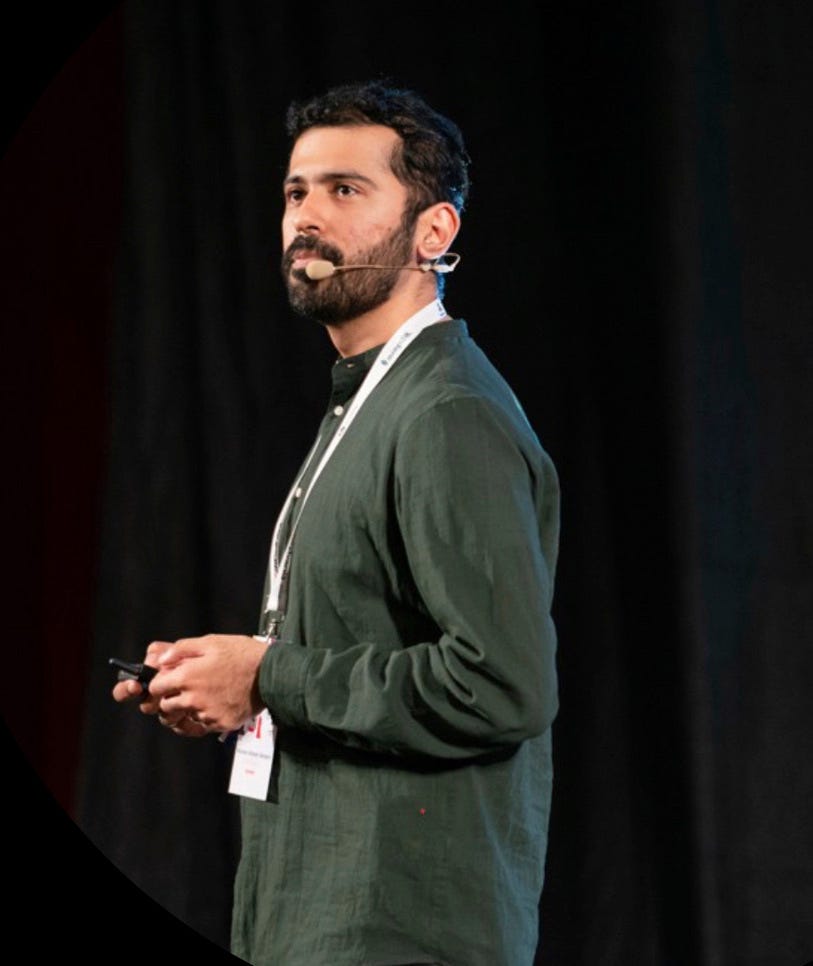Remaining Relevant in an AI Age.
The Future Does Not Fit in the Containers of the Past. Edition 151.
The history of AI is over 80 years old.
You can learn and view its developments here at the online Computer History Museum site.
After many ups and downs, false dawns and surviving many winters AI or what Ted Chiang, the author calls “Applied Statistics” has arrived due to a combination of access to swaths of training data available on the Internet, massive increases in computing power and several breakthroughs in neural network design.
Today a combination of daily breakthroughs and exponential improvements combined with tens of billions of dollars of capital means that every company, every job and every one of us will be impacted by AI.
How do individuals and firms adapt and thrive in what clearly will be a new landscape?
3 steps.
1)Embrace. 2)Adapt. 3)Complement.
Embrace
It’s 1977 and a new movie titled Star Wars: A New Hope is released and in it a General Dodonna ends a briefing to his fighters (which includes Luke Skywalker) with the words “May the Force Be With You” (watch this scene from what is now nearly five decades ago not just for the line but how far film making technology has advanced and hear the line first time it was said…it was not Obi-Won Kenobi or Yoda.)
It's 1599 and somewhere in England a play by William Shakespeare is staged during which the following lines are spoken (listen to them voiced by John Gieguld to understand why Shakespeare is best heard and not just read):
"We at the height are ready to decline.
There is a tide in the affairs of men
Which, taken at the flood, leads on to fortune;
Omitted, all the voyage of their life
Is bound in shallows and in miseries.
On such a full sea are we now afloat,
And we must take the current when it serves,
Or lose our ventures."
Both Shakespeare over 500 years ago and George Lucas 50 years ago shared the first rules of thriving in changing times.
Align with the force.
Go with the flow.
Every individual and organization should and must spend time learning and understanding this new tsunami.
It is real. It is powerful and it is moving extremely fast.
Yes, there are lots of issues from copyright to impact on employment to a terminator like bot getting all of humanity, but the genie is out of the bottle, there is no going back or time for individuals or organizations to dither.
As an individual it is essential to begin to understand Re-Generative AI including prompt to text (e.g., GPT-4), prompt to image (e.g., Mid Journey), prompt to audio (e.g., Voice lab) and prompt to video (e.g. Runway ML). One way to keep up daily is to subscribe and read this free daily note called Ben’s Bites.
Another good place to start experiment with prompt to text is here at Pi (Inflection AI a one-year-old company which powers Pi this week raised 1.3 billion dollars from Microsoft and Nvidia among others.)
Adapt
Organizations need to re-think and re-visit every aspect of their products and services to see where productivity can be enhanced, product and services augmented, and completely new innovations launched.
And it is not as simple as automating and speeding up things as we have learned from a lawyer using AI to help in a legal case only to find that the AI had made things up (and increasingly this will be a huge issue) but a far deeper re-architecting of the business versus just a re-skinning or a re-structuring to cut costs.
The three big questions are:
a) What can be AI enhanced and what should not?
b) How will the AI product be built/trained and what quality control will ensure that the result is safe and legal among other things?
c) How will the organizational design and talent allocation change to incorporate these new capabilities?
For most companies there is good chance that AI technology itself will become a commodity like ingredient.
In fact, smaller companies (outside of the mega cap tech companies that are funding and driving AI investments) are likely to benefit more from AI since it will now make amazing capabilities affordable to everybody.
Size maybe less of a competitive advantage.
Well thought out processes for yesterday may become anchors to change.
And even senior management who cannot adapt fast (AI is scaling so quickly it is wishful thinking for senior folks to believe one can delay things till retirement) will become a competitive disadvantage.
But a key to adaptation will be how to attract and retain talent to work in new ways to complement the AI.
Because the future will not be just an AI age but an HI age
HI= Human Inspired.
Complement
Successful individuals and companies will complement the power of computing machines and software.
They will do this by enhancing, training, and bending what the technology can enable with creativity, storytelling, empathy, provenance, humanity, insight and imagination.
There will be a premium on building and attracting talent who are strong in the 6 C’s.
Three of these have to do with individual competence (Cognition, Creativity, Curiosity) and three how we connect with each other and the world outside our minds (Collaborate, Communicate, Convince).
Cognition is simply learning to think and keeping our mental operating system constantly upgraded. This requires deliberate practice and sustained work. Improved cognition is achievable and essential in a world where the computing operating systems are constantly improving.
Creativity is connecting dots in new ways, looking beyond the obvious and this skill will be key as AI powered computers, data crunch and co-relate faster than we ever will.
To be human is to be creative.
Creativity is at its heart the way we deal with a world of change by adapting, evolving, and re-inventing.
We need to learn and feed this inside us. The future will be about data driven storytelling and not just data or storytelling and the ability to leverage modern machines and algorithms to unleash connection and meaning will depend on creativity.
Curiosity is simply being alive to possibilities, questioning the status quo and asking what if? Today the key competitor or opportunity in any category comes from outside it.
Being cognitively gifted, creative, and curious will not be enough since we are living in a connected world where eco-systems, teams and linkages is how ideas are born, value created, and long-term careers forged. For these we need to hone and build and train for three other skills which are key since a great part of Human Inspired work is not just how to work alongside the machine but work alongside other humans.
Collaborate: Collaboration is key to work in a world where API’s (Application Protocol Interfaces) are not just about handshakes between software/hardware but between individuals with different skills, teams in different countries, partners, suppliers and much more.
Communicate: Learn to write. Learn to speak. Learn to present. It may be so old school but watch the people who succeed, and they are good at communication. And all of these can be taught and learned. One can use GPT to write the first draft and have Mid-Journey come up with great visuals for presentations and use other AI tools to provide amazing starter ideas and be a great co-pilot but Human Inspired means taking these outputs to the next level and requires communication skills.
But communication is not a one-way street and as important as it to write, speak and present it is as critical to be able to listen, to hear and to understand what others are saying with an open mind and a sense of empathy since this will also be a differentiating advantage in an AI age.
Convince: Every one of us is a salesperson regardless of what we believe our title is. This is true even if we do not sell anything at work. We must convince colleagues of our points of view.
We all must learn to convince and learn to sell often finding ways to sell something different than what the machines may recommend.
Time has proven that technology while bringing with it risks and downsides over time is a massive positive force for humanity.
The future is bright and all we must do is open our eyes, heart and minds and seize the benefits of this amazing era.
(To learn how Brands and Companies should think about AI content listen below from a leading Cambridge academic who also is an AI entrepreneur).
Photography by Xuan-Hui Ng
The Camera Always Lies? Dr Mansoor Ahmed-Rengers is the founder of Frankli and OpenOrigins and a researcher at the University of Cambridge. In this episode he discusses how to combat media manipulation tools such as deepfakes and generative AI. Mansoor predicts that once the hype dies, AI-generated content will be seen as cheap and derivative and that prestige brands will want to distinguish themselves by showcasing human-made content. Brands that completely divest from old school, non-AI ways of creating content will realize it was a massive mistake in a matter of 3-5 years.
Rishad Tobaccowala helps turbo-charge companies, teams and leaders growth by helping them see, think and feel differently. Forty years of experience delivered through writing, speaking and advising in ways that are actionable and inspirational. For more about Rishad Tobaccowala click here.






Thank you for a comprehensive view of combining the best of humans & machines for a better future. With super intelligent digital assistants communicating with us in natural languages, students will learn better/faster, solutions/insights are discovered more easily with less cost, and more effective plans are generated for better outcomes. So embracing AI with the appropriate guardrails can create a better future for humans & other forms of life.
Excellent piece as usual. When I read the descriptor for the podcast episode with Mansoor, it struck me that human vs. machine driven brands will mimic the luxury vs. mass phenomenons of yesteryear. The artisan crafted products will be loved for their humanness. The mass offerings will find their markets and the hybrid of those two will serve yet another market. It just isn't obvious yet.